

Making roughly $86 billion in revenue every year, the moving industry in America is booming.
In fact, since the Great Recession, the moving industry has grown at a steady rate of 3% and sees an average of 31 million people relocate every single year. Not even the pandemic slowed it down, as of April 2021, more than 38% of Americans plan to move in 2021.
Right now, there are 50,000 moving trucks in America.
But, they don’t all belong to conglomerates or household names like U-Haul. In fact, there are over 7,000 moving industry companies operating in 13,900 locations in the US. Most of them are small companies, with 47.8% of them employing less than 5 people.
The moving industry is an amazing place for small businesses in America. And one way to help your moving company to thrive in this growing climate is to utilize the power of PPC.
PPC (Pay Per Click) advertising is a way of getting your business seen by customers at the moment that they are searching for your business and services. Using Google Ads, you’ll be able to promote your moving company to users the second they are searching for someone to help them move.
The possibilities of that can bring more customers, more bookings, increased revenue, and an amazing return for your company. If you’re not convinced yet, take a look at these stats for PPC marketing.
What’s more, users are 4 times as likely to click on a paid ads from Google than any other search engine. When you combine that with Google’s research that, when done right, their paid advertising can give companies $2 back for every $1 spent, you can be sure that your moving business will profit with Google Ads.
Okay, we’ve established why PPC can be important for your business. But just how much of a return can one see from their marketing on Google Ads?
First of all, with paid advertising, you need to understand that there’s no set cost for anything. You don’t pay one price for a billboard, you pay each time someone clicks on your advert. This means you’ll be on the lookout for metrics such as:
Do keep in mind that you are billed upon billing thresholds that you set. i.e. every $200, $500 or $1000. In other words, you are not billed your full monthly budget upfront.
In simple terms, your ultimate return on investment will be how much money and revenue your company is able to generate from your conversions, versus how much you paid for your advertising.
Unfortunately, the harsh truth is that like with any form of advertising, you can’t guarantee anything. The end results depend on how much you invest, how your account and campaigns are set up, and ultimately the market that you’re in.
At Declare, we’ve achieved very low CPLs of below $30 for moving companies.

It’s a simple math equation to see if you’re numbers will work. Plug in your numbers when doing this exercise (in your specific market and based on your average move price), but take note of the average moving prices above.
Let’s say you’ve got a $3,500/mo budget for Google Ads. If you are paying $28 per lead and getting around 125 leads. You can assume that 15-20% of your leads will convert into a paid customer. Let’s assume 18 leads of the 125 convert to paid moving projects. At the in-state average moving price then the total revenue from moving projects booked from Google Ads is $39,150. Not too shabby from $3,500 in advertising cost.
Ready to harness the power of PPC and create your own Google Ads campaign for your business? Or, if you’re already advertising, want to learn some tips and expert advice on how to manage and get the best from your campaigns?
No matter what your experience is, we’re here to help. Read on to discover how to set up and create google ads campaigns to get more customers for your moving company.
Dreaming big is great in theory, but not when it comes to planning and creating your Google Ads strategy. Instead of thinking about becoming the best moving company in your area, or making double, or even triple returns on your investment, you need to slow down a little bit.
These goals are great to have to drive passion, but for Google Ads and PPC let’s take a step back. Do you want to use PPC to:
The most logical answer here is that you want to use Google Ads to drive more qualified traffic to your site AND generate more leads. Once you’ve got this goal nailed down, we can start crafting the perfect strategy for your business, and ultimately work closer to those big dream goals of being the best.
Once you know your goal, you need to decide what type of advertising that you’re going to use to achieve it.
In general, Google Ads offers two main types of advertising:
Although Display Ads might look fancier, text ads are one of the most used and popular types of PPC that your business can use, with 49% of users clicking on text ads above any other form.
Text ads are also great at pinpointing exact moments that your customers will be needing your company by targeting keywords directly relating to your company. So, if someone is searching for a moving company in New York, your ad will be ready and in position, for the moment they make their choice of which company to use. This makes text ads a very lucrative option for lead generation or conversion goals.
If your goal is brand awareness, Display Ads are one of the best options that you can pick. That’s because the Google Display Network reaches more than 2 million websites and apps, offering more power and attention than the text ad can offer. In fact, Google claims that its Display Network reaches over 90% of Internet users worldwide. Now, that’s some attention your company can be getting.
With the Display Network, you don’t have to wait until your potential customers search for you. You can target them anywhere, anytime, while they’re using their favorite websites or even browsing for related items, like property websites or listings in your area.
For first-time advertisers, we’d recommend getting to grips with text ads first before venturing into display ads. This is especially true for those that might not have the time, or resources, to create images or videos to be used on the display campaigns.
However, before you get worried about choosing between text or display ads, remember: you can have both. There’s no pressure to decide for your entire advertising life now. All you need to do is pick what you want to get started with.
The Declare recommendation: Generally speaking, most moving companies should start with search ads and leave display ads until later on if it fits within budget and goals.
Keywords are the backbones of great Google Ads campaigns. Without them, you wouldn’t have accurate control of where your ads would show, meaning a lot of wasted money, time, and potential.
Basically, keywords are what control what searches your ads should show up for. If you want to give your company the spotlight every time someone searches for terms like:
You need to make sure that you have the right keywords built into your campaigns. To help you get started, we’ll list the steps that you need to take next.
The first step of keyword research is to come up with a list of keywords. Seems pretty simple right?
To do this, you need to focus on your core starting points and what’s on offer. Going through your services and using tools like Google’s autofill or AnswerThePublic are great ways to start filling in the blanks.
For example, if your moving company is based in Florida, and you offer both short moves and interstate moves, you might want to start on the core keywords of ‘Moving company Florida’, ‘Moving Florida to New York’, ‘Cross country moves Florida’, and so forth.
Once you’ve got your core topics and keywords, try putting them into tools like Keyword Sheeter to create a rapid list of related keywords from autocomplete suggestions on search engines.
Now you’ve got a big list of keywords, it’s time to look at which ones are going to be valuable for your campaigns. A great tool for this process is Google’s own Keyword Planner tool, which will be a part of your Google Ads account.
Google’s Keyword Planner shows you information related to your keyword and related keywords, including important metrics such as bid estimates, search volume, and the level of competition that the particular keyword has.
These are important metrics to pay attention to and will help you to vet and pick out which keywords deserve your bid, and which will just slow your campaigns down.
First, bid estimates show you how much a bid on that keyword will cost. Some keywords are going to be more expensive than others, particularly if a lot of companies are also bidding on them. So even though ‘Moving company Florida’ might be a great keyword for you, if the cost is too high, you might want to consider using your budget on cheaper alternatives instead.
Secondly, search volume shows the number of people that search for your keyword. The higher the volume, the more people are looking for it, and generally speaking, the more expensive it will be. When looking at this metric, don’t fall into the trap of thinking that the bigger search volumes will always be the best. The best strategies have a mix of keywords at different volumes, aiming to capture audiences at different parts of the purchasing journey.
Lastly, the competition shows you how many other companies are also bidding on this keyword. The more companies that compete, the harder and more expensive it will be to get your company to win the bid and get your ad shown at the top of the page.
If you’re working on a smaller budget, you don’t want to throw all your eggs into baskets that will be easily outbid. Make sure that you aim for some low and medium competition keywords to dominate smaller searches instead.
While researching and vetting your keywords, you need to keep a little something called keyword intent in your mind. Keyword intent is the intent that a user will have searching for the particular keyword in the first place. Take these keywords for example:
The first search is for someone that’s likely to move from New York to Atlanta and they’re ready to purchase and book the services of a moving company. These are your golden ticket searches, but will often be the most expensive and heavily bidding on.
The second search would have been made by someone who could be a potential customer, but they’ve not made their mind up yet about purchasing your services. They’re searching for information about moving companies and need that extra little push into making a purchasing decision.
The third is someone that’s looking to move by renting a van, rather than looking for a company to do it for them. This isn’t a search you want to appear for, but we’ll tell you how to remove this from your options with negative keywords.
And finally, the fourth is someone who’s looking to work within a moving company. They’re not your potential customers, they’re your potential employees. If you’re trying to get leads, you don’t need this term for your strategy.
If you’re working on your moving company SEO strategy at the same time, this type of research will also help aid your content.
Over the past two years, Google has been making a lot of changes to the way their keyword match types work. Right now, there are only three match type options:
Exact match keywords match your keyword to searches that either include the exact same phrasing or intent. So, if you have an exact match keyword of ‘Moving company Florida, you will come up for searches of ‘Moving company Florida’ or ‘Moving business Florida’.
You won’t appear for searches like ‘The best moving company in Florida’ with an exact match keyword, as it doesn’t exactly match the keyword or intent.
Phrase match keywords used to be defined by triggering searches that included your keyword, but added extra words or phrases to either side of the search.
For example, under a phrase match keyword, ‘Moving company Florida’ would trigger searches like ‘The best moving company Florida’, ‘top-rated moving company Florida reviews’, or ‘moving company Florida to Kentucky’.
Under the new update, phrase match keywords also include searches that match the intent or meaning of your search, giving them a broader scope than they traditionally used to reach.
Broad match is the standard keyword match types that Google offers and what will be used if you don’t set a match type. Generally, broad match keywords are designed to match the most searches, giving companies a wider reach than exact match or phrase keywords could offer.
However, some broad match keywords may trigger searches that are a little too far away from your keyword intent, such as ‘moving company jobs in Florida’.
You’ll want to deploy a very robust negative keyword list before considering running broad match keywords. Which brings me to my next point…
Remember those searches that we didn’t want to show up for? The way to prevent that is through negative keywords.
Negative keywords are a way of adding exclusions to your keyword list, so your business doesn’t waste budget bidding for searches that just aren’t relevant, like the ‘Moving vans for hire’ or ‘Moving company jobs’ searches we mentioned earlier.
By adding negative keywords ‘jobs’ or ‘van hire’ into your list, you will prevent your ads from being triggered on these searches. Other keywords you might want to think to add are:
And so on. You can add negative keywords at any time, meaning that if you spot your ads being triggered for searches that aren’t relevant, you can go back and add these keywords at a later date to prevent it from happening again.
You might be surprised at some of the searches that will trigger, but your budget will thank you for managing these with negative keywords.
Google Ads has three layers of organization, and you must understand what each one is for and how to structure them at their best to get the most from your campaigns.
To get the best out of your Google Ads, you need to make sure that every campaign and subsequent ad group has a clear focus that aligns with the goal you created earlier. For best practice, you should never try to sell or achieve everything within a single campaign.
Instead, create different campaigns to focus on a single service, topic, or offer. For example, you could create one campaign for interstate moves, and one for cross-state moves.
Then, inside each campaign, you want to get even more specific. So for the cross-state moves campaigns, you could separate the ad groups based on locations, such as California to Texas.
Within the California to Texas ad group, you’ll then put in the keywords and ads relevant to only that move and service. So when this ad triggers, it will be incredibly targeted to the search and deliver you better results.
What’s more, having more relevant ads will also help increase your Quality Score, meaning your ads are more likely to place higher on the page for a lower cost.
Okay, now we’ve got the structure of your Google Ads sorted, it’s time to think about what goes into the ads themselves.
Luckily, you don’t have to be a great writer to write a great advert. You just need to understand what your customers are looking for, then cater to that. So what do your customers want?
75% of people say that they click ads because they expect them to answer their questions.
What this means, in a nutshell, is that users want to see ads that are directly relevant to the search that they have performed and will give them the answer or service that they are looking for.
Put yourself in your customer’s shoes. Think about why they’ll be making that search, then use that to power your text ads.
Starting from June 2022, Google Ads is getting rid of expanded text ads in the move to responsive search ads. For you, this means that Google will give you an extra helping hand in choosing the best copy for your ads.
Before, you had to submit:
For each ad in your ad group. When you wanted to make a change or test your performance, you’d have to go back and enter more ads or edit your existing options.
With Responsive Search Ads, Google lets you add between 3-15 headlines and 2-4 descriptions to automatically test which ones perform better for your ads.
Keywords aren’t the only ways to ensure that your ads are displayed to your customers. With Google Ads, you can add several advanced targeting options to your campaigns (particularly your display campaigns!).
This includes a range of settings such as:
And more. To get the most out of your campaigns, we recommend adjusting these settings to focus on your audience.
So, who should you be targeting? As we found out earlier, gnarly 38% of Americans plan to move in 2021. Now, that’s a big audience, so let’s break it down into individual people.
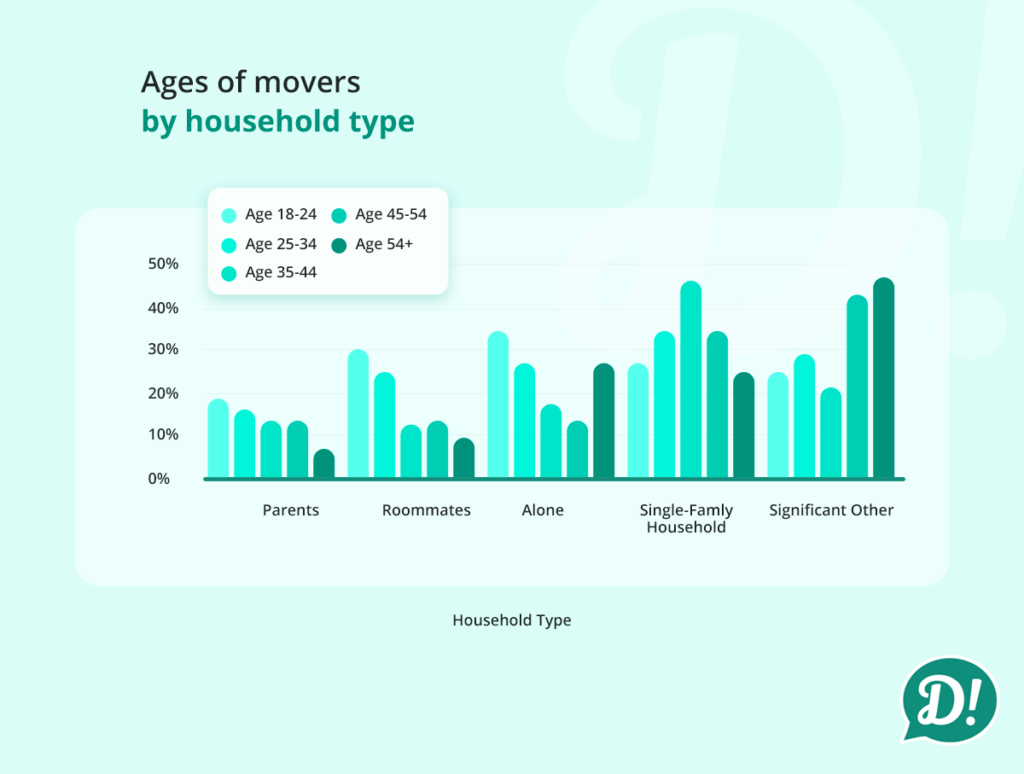
The average mover in the US is between 18-34 years old, with 1-2 children. The older the demographic, the less likely people are to move, as they’re more likely to have become settled in their ‘family’ home.
To speak further to the home ownership statistic mentioned above, see the following illustration of home ownership in 2020:

Here’s a chart illustrating the age of people who moved this past year:

That’s just the average mover of course. You will find particular trends and demographics for your particular area and the types of moves that you offer. As well as the above, you should also consider that:
As well as keeping these in mind for your targeting, you might want to create separate campaigns and targeted ad groups to these other demographics or types of moves.
You can also tailor your advertising to the size of households moved. The latest data shows:
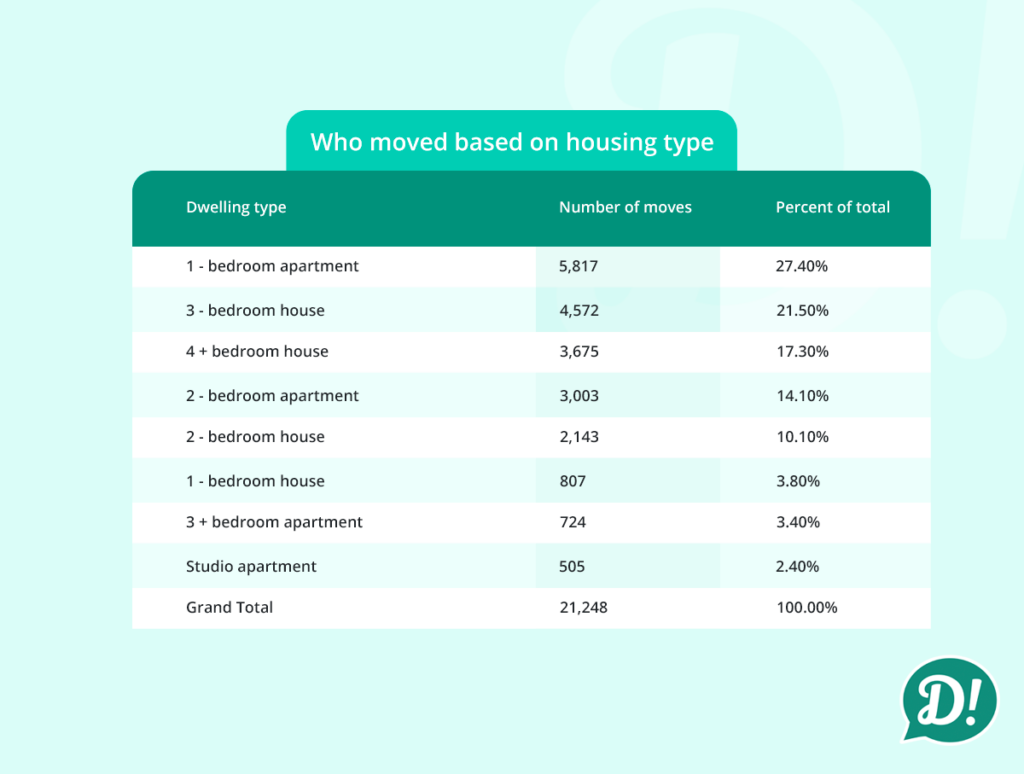
In terms of the types of moves that people do, see below:
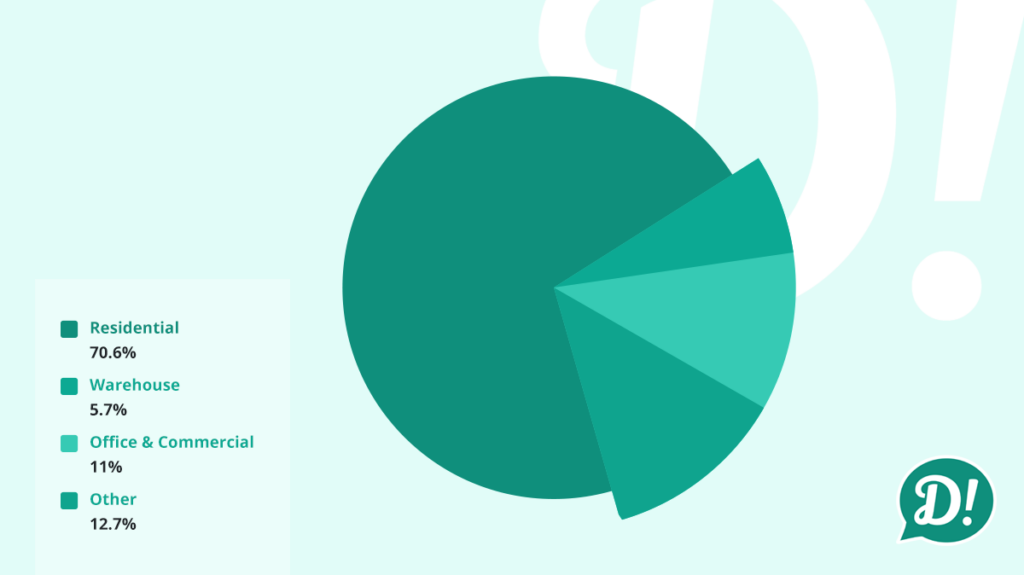
Use this information to make sure that you’re targeting the right people for the right advertisements. The more targeted and relevant you can get your campaigns, the better the results and the return that you can make.
It’s important to treat each type of move within it’s own campaign. Also, residential breaks down even further to local vs long distance. See the following:
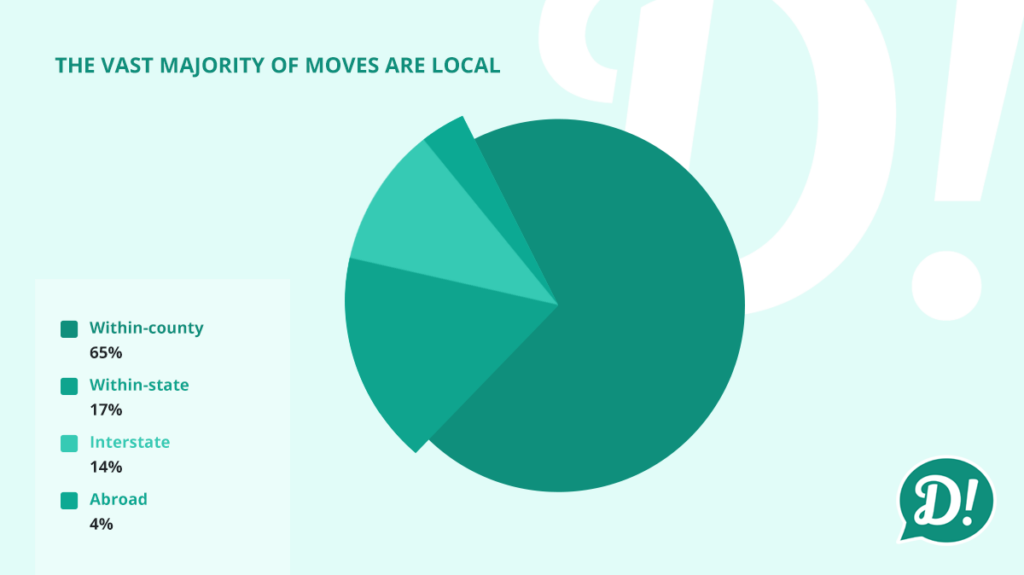
In the moving industry, as I’m sure you’re well aware by now, you have busy seasons and quiet seasons.
Almost half of the moves for a year take place from the beginning of May to September, normally slowing down after Labor Day. During this period, 60% of all annual moves take place.
However, in 2020, September was the biggest month for moves of the year, which could have been somewhat caused by summer delays from the pandemic.
Now, it might seem like a simple thing to say, but you’re not going to get the same results from your Google Ads in July as you are in December. The busier the moving season, the more attention, clicks, and conversions that your ads are going to make.
For you, that means that instead of thinking about your budget as the same for the entire year, you might want to plan to spend more during your busier months to take advantage of that rush. Alternatively, if you’re planning to use Google Ads to help make up for your slower months, you may want to push more of your budget to the off-season months.
As well as your budget, you will also want to think about making sure that the message you use is relevant to that time of year. If you’re in peak season, stress the urgency of booking a month and how things are selling out fast. If it’s off-season, promote your benefits and why your audience should choose your company, as they’ll have more time to shop around. You might also want to consider discounts or promotions.
As well as the time of year, the date, day, and time can have a big impact on your Google Ads performance. Most moves in the US took place on the 1st of the month, followed by the 15th and the end of the month.
For days of the week:
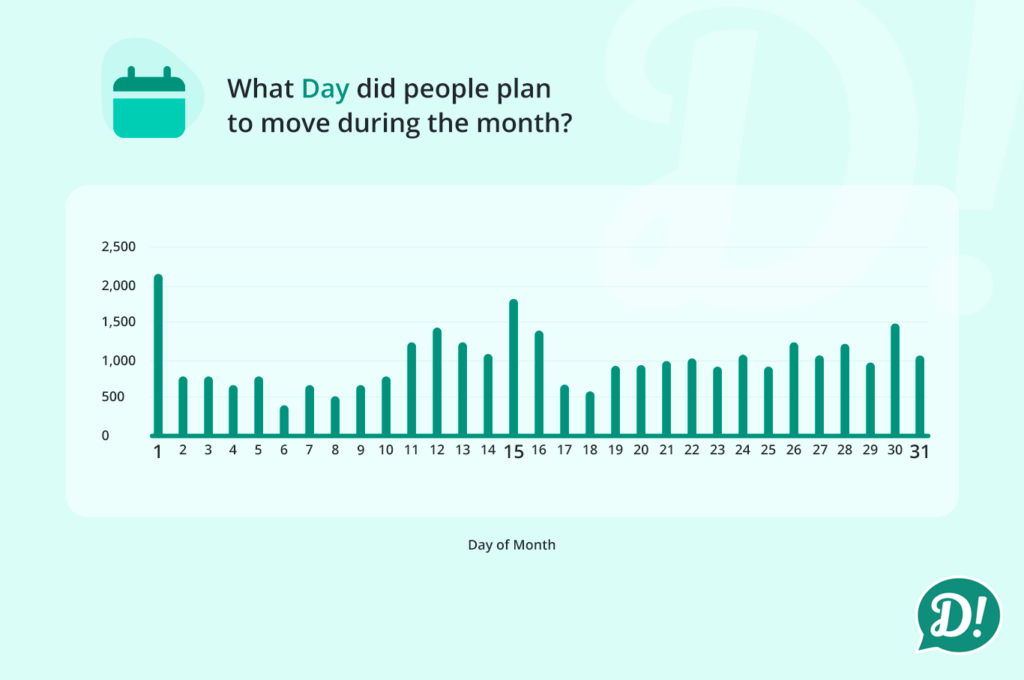
Knowing which day will be the most requested, you can up your budget to show more ads and use more of your budget on peak days.
When you view your performance, you can also see at what times of the day are most popular for your customers and create ad scheduling to match. This makes sure that your campaigns are only seen on the times and dates that you specify, saving your budget for your most popular and profitable times.
Google provides two main location settings in Google Ads:
How you use these location settings will depend heavily on the services that you offer.
The majority of Americans don’t move that far.
What this means for you, is that when you’re setting up location targeting you’re going to want to use location 1 for these campaigns. These movers are already near the physical location that they want to move to, so you’ll be able to narrow your focus and make better use of your budget through location setting one.
For best results, we’d recommend putting same-state or city services in its own campaign, allowing you to create ads specific to this service. For example, if you offer moves in New York, you could target keywords such as: ‘New York moving company’ ‘best moving company NYC, and ‘moving company Brooklyn. By excluding those not already in this location, you prevent your spend being wasted by those out of state who are considering moving into the city and would need a different service.
For cross-state moves, you’ll want to use location setting 2 to make sure that the people moving into the set location will be able to see your advert.
You may want to consider the biggest moving routes that people use to narrow down your focus. For example, the busiest moving routes are:
When using location settings, you could also tailor campaigns for locations that people are moving away from, as well as too, which line up with your servicing offering.
According to the American Moving and Storage Association, these are the most popular states that people move into, and from.
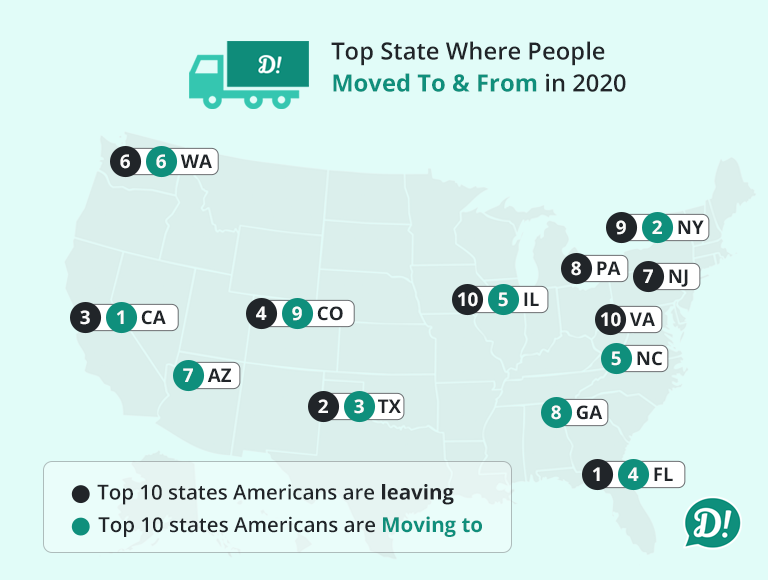
Specializing in PPC for moving companies, we’ve helped moving businesses achieve incredible results with Google Ads.
If you want to experience the profit, without the hard work and management, you’ve come to the right place. Call us today at (646) 419-5496 or contact us online to discover how we can transform your Google Ads success.
Enter your name + email to watch this free training video